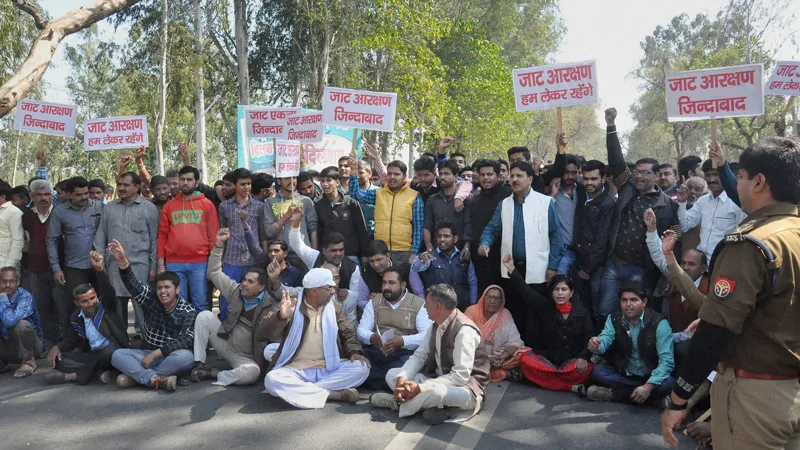-
CENTRES
Progammes & Centres
Location

After Patels and Kapus, it was the turn of Jats to agitate for the prized OBC (other backward classes) tag, entailing benefits in government jobs and higher education. The spontaneous and leaderless agitation which sprung up initially in a handful of district towns of Haryana quickly spread to many districts in the State and the adjoining States of Uttar Pradesh, Rajasthan and Delhi, seriously impacting transport, movements of essential goods and bringing normal life to a standstill in areas of their influence. The disturbing aspect of this quota stir is the degree of violence and wanton destruction of public and private properties unleashed by the agitating members of the community. One has not seen a similar protest by an aggrieved community which involved in blocking lifeline resources such as water, burning down an entire township and selectively targeting non-Jats properties and symbols in a brazen manner. Why Jats are so angry?
While analysts link the present stir to the loss of political clout (state having a non-Jat chief minister), there are more pertinent reasons to the ongoing stir. Fear of losing social and economic status to other competing castes and the inability to capture the quota pie despite their numerical strengths and considerable political clout are what driving the current Jat stir. In many ways, the present Jat agitation is a mimicry of Gujarat’s Patidar stir. Yet, the larger narrative behind Jat stir is the relative loss of economic power and the seeming inability of the average members to prosper from the neo-liberal economic order. Jats are not alone in this structural shift. Most peasant castes who prospered from the green revolution in previous decades are in deep trouble due to agrarian distress and continued stagnation in rural economy.
This is further compounded by the fragmentation of land holding. According to 59th round of national sample survey, from 2.63 acres in 1960-61, the land holding has taken a sharp decline to 1.06 acres in 2003-4, clearly indicating the growing pressures on members to do something else. Their ideal destination would be city. But with the private sector creating very few jobs and cities turning unwelcome place especially for people with low skills, peasant castes like Jats and Patels face a grim prospect. Thus, the only decent way to keep them in contention (in politics and bureaucracy) is by getting listed in the quota categories. At a time when average private sector jobs look unrewarding (while the average daily earnings of workers was INR 249 in 2011-12, the public sector average for the said year was INR 679), there is obvious hankering for a government job. Thus, it is not surprising to see more and more peasant castes such as Marathas, Kapus, Patels and Jats furiously raising the quota bandwagon. In short, the agrarian distress and the structural problems afflicting India’s economy are pushing the erstwhile forward communities for the “backward” tag.
Should Jats get OBC tag?
At a time when many socially dominant and politically powerful groups have muscled their ways into OBC categories, why should Jats be left behind? There are plenty of instances in which caste groups have managed their ways to the OBC list, largely because of their numerical strength and political clout than any compelling reasons. In the recent time, the Gujjars could force their way to the special backward category in Rajasthan. In the past, dominant intermediary caste groups like Vokkaligas and Vanniyars have muscled themselves into the Karnataka and Tamil Nadu OBC lists respectively.
Of course, the Jats are listed as OBC in all other eight states other than Haryana. Those who have studied the socio-economic conditions of this land owning community would know that the Jats of Uttar Pradesh and the Jats of Haryana are in the near similar situation. Yet, Jats in Uttar Pradesh have been accorded the OBC status, while the Jats in Haryana are not. By saying this, one is not supporting the claims of Jats in Haryana, but merely pointing out the absurdity in OBC selections and the politics involved in determining the group eligibility for such inclusion.
OBC reservation – A broken system
It is a known fact that the affirmative action with regard to OBC is a broken system. One must remember that the entire fracas around the OBC tag is not about affirmative action to address historical injustice or caste oppression as they are in the case of SCs and STs. This is about “power” and domination in relation to other powerful caste/social groups. The manner and methods in which the Mandal Commission selected groups (using 1931 caste census and relying heavily on caste as the key source of determining backwardness than educational and economic factors), it was bound to antagonise groups at a time when class and caste have taken huge structural shifts and the economy is creating fewer jobs and other income generating opportunities. The worrying point as witnessed in the case of Jats, Gujjars and Kapus is the use of violence as the chief weapon to get grievances heard. With states meekly surrendering to such tactics (rewarding violence), India is precariously placed to witness many more such agitations in the time to come.
The views expressed above belong to the author(s). ORF research and analyses now available on Telegram! Click here to access our curated content — blogs, longforms and interviews.

Niranjan Sahoo, PhD, is a Senior Fellow with ORF’s Governance and Politics Initiative. With years of expertise in governance and public policy, he now anchors ...
Read More +